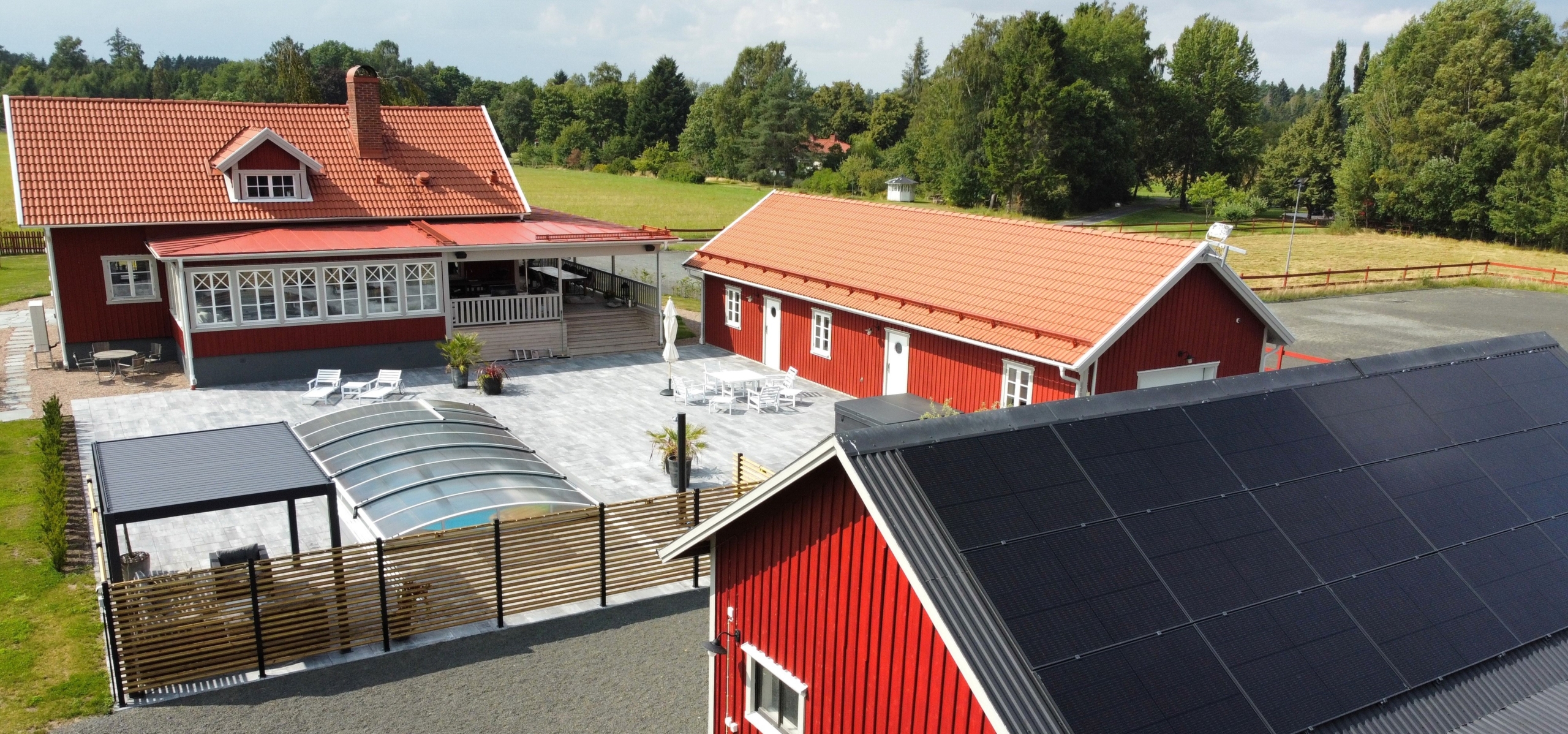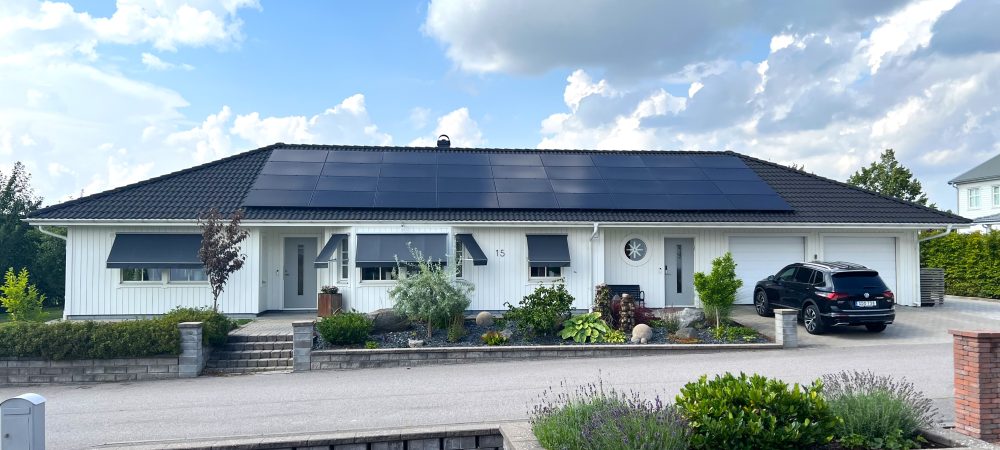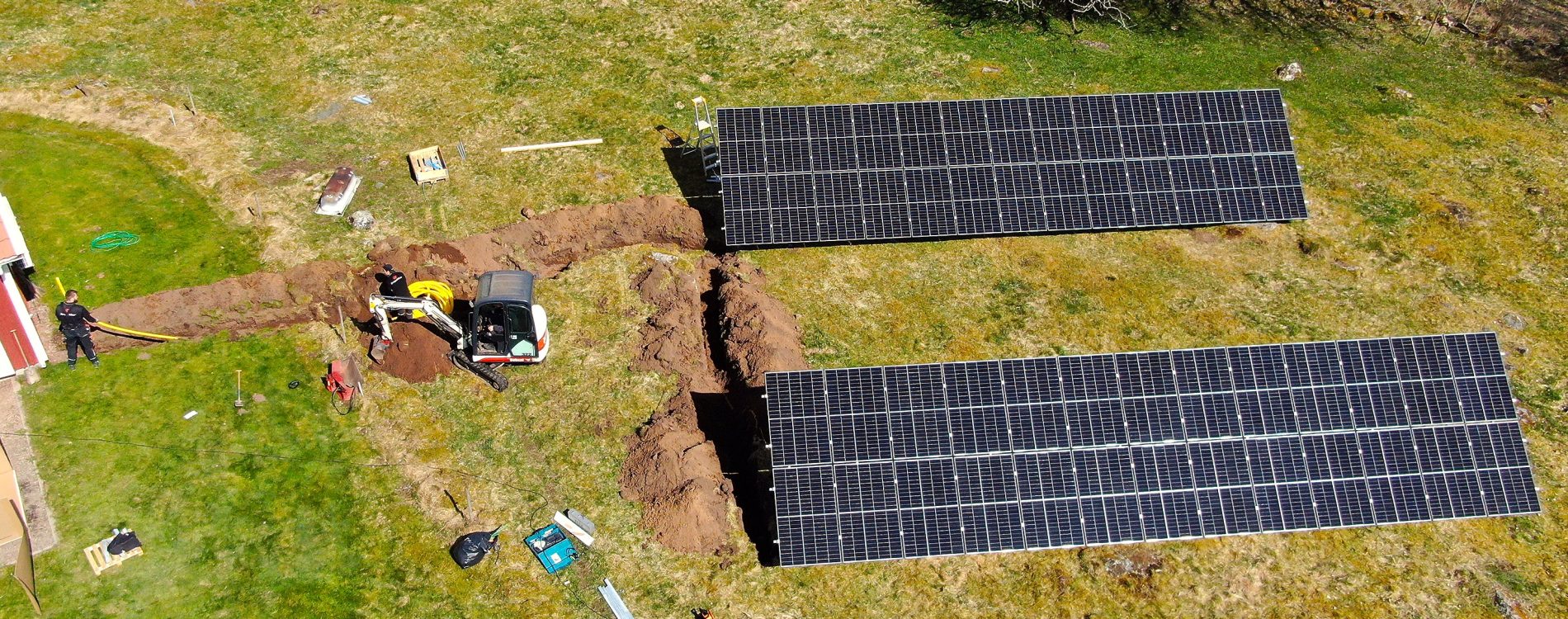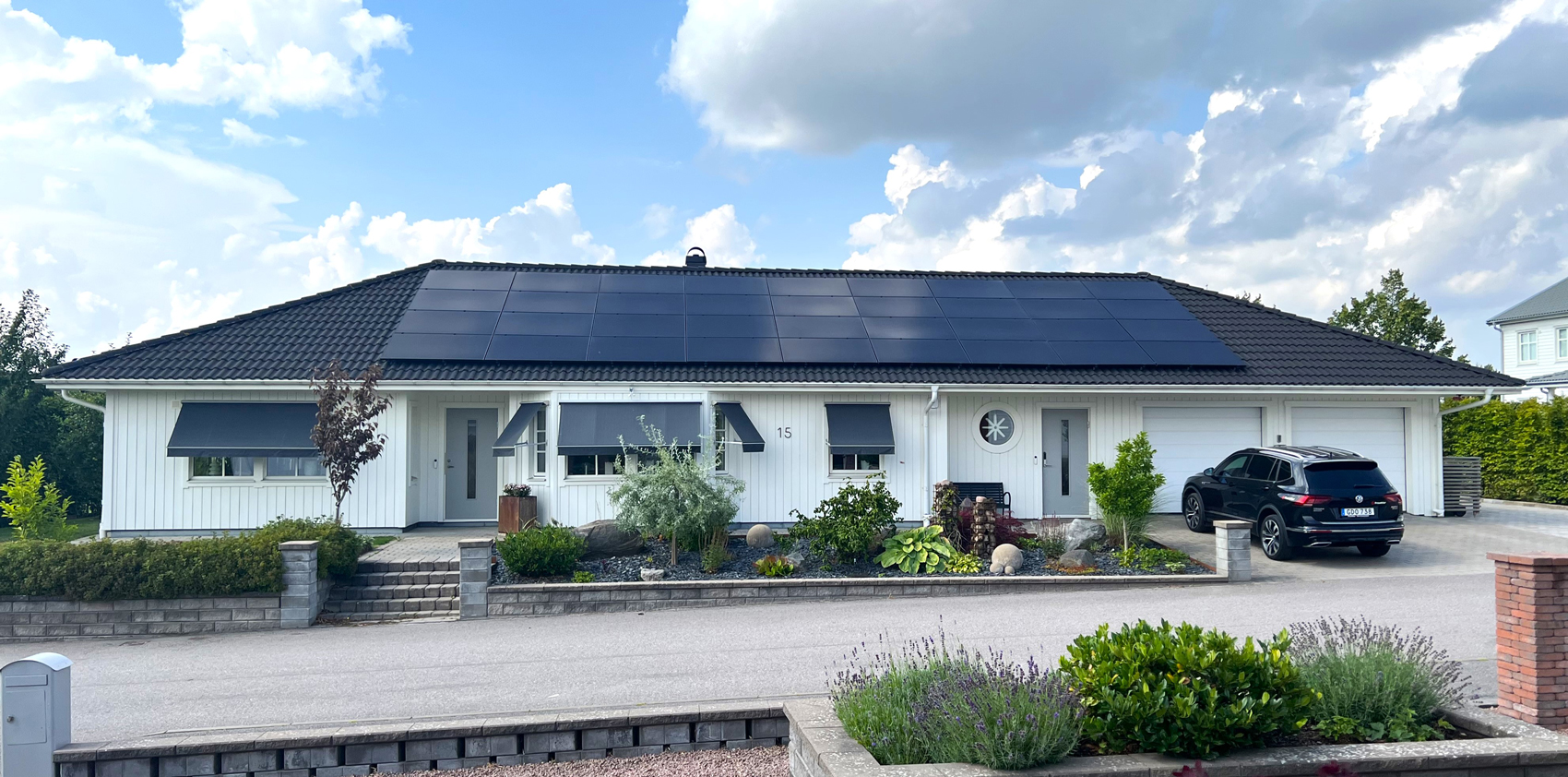
Solenergi för privatpersoner
Här får du veta det mesta du behöver veta om solenergilösningar för privatvillor. Längst ned hittar du en omfattande FAQ-sektion som kan vara intressant även för proffs.
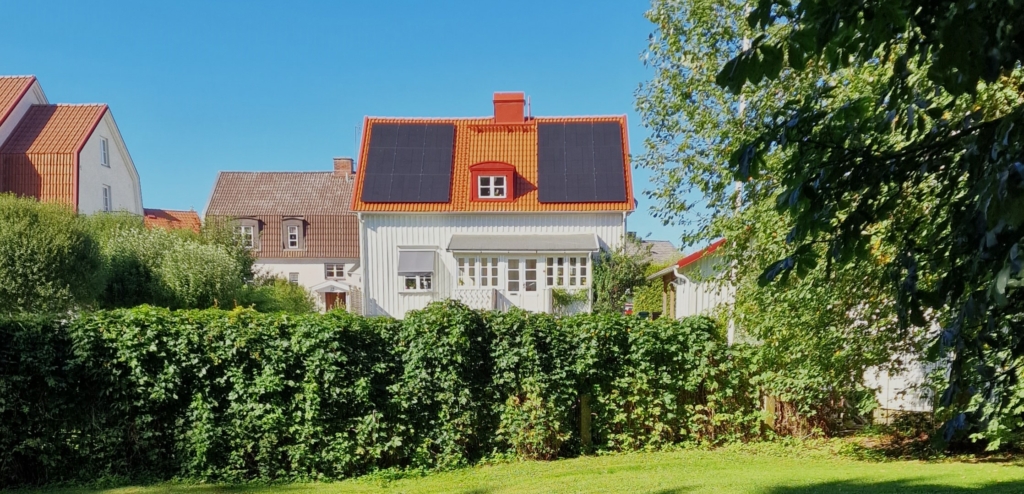
Solenergi för dig i villa
Solceller på villataket är idag en mogen teknik med väl beprövade system, som är mer intressanta än någonsin – för det enda vi kan vara någorlunda säkra på om framtidens energipriser är att de förmodligen kommer att vara betydligt högre. De bidragande faktorerna är många. Vi i Sverige är numera sammankopplade med den europeiska elmarknaden, som präglas av allt mindre reglerbar energi (som t ex kärnkraft). Man vill också minska importen av gas, samtidigt som transportsektorn elektrifieras i snabb takt – och här hemma står vi inför enorma, elberoende industrisatsningar. Alla konkurrerar de med dig och alla andra hushåll om den el som utbjuds på marknaden, med allt högre priser som följd.
Servicebesök – säkra maximal effekt på din solenergianläggnin
Din solcellsanläggning är en viktig investering som sköter sig själv – men inte helt! För att garantera optimal produktion och säker drift rekommenderar både vi och Elsäkerhetsverket regelbundet underhåll.
Varför ett servicebesök?
– Upptäck och åtgärda slitage i tid.
– Säkerställ att kablage och anläggningen är i toppskick.
– Förläng livslängden och optimera produktionen.
– Termisk översyn med värmekamera & drönare (tillval)
Våra elektriker går igenom hela din anläggning och levererar en detaljerad rapport med eventuella åtgärdsförslag – allt för att du ska få ut max av din solenergi!
Åtgärder som behövs av mindre karaktär och går att avhjälpa direkt på plats med det material och verktyg som finns så gör elektrikern detta. Om felet inte går att avhjälpa direkt återkommer vi med ett kostnadsförslag och bokar en tid för när felet kan åtgärdas.
Vi berättar gärna mer! Kontakta Andreas eller Jesper- De börjar med att sätta oss in i fakta kring din solcellsanläggning, liten som stor, för att därefter gå vidare med anpassat upplägg.
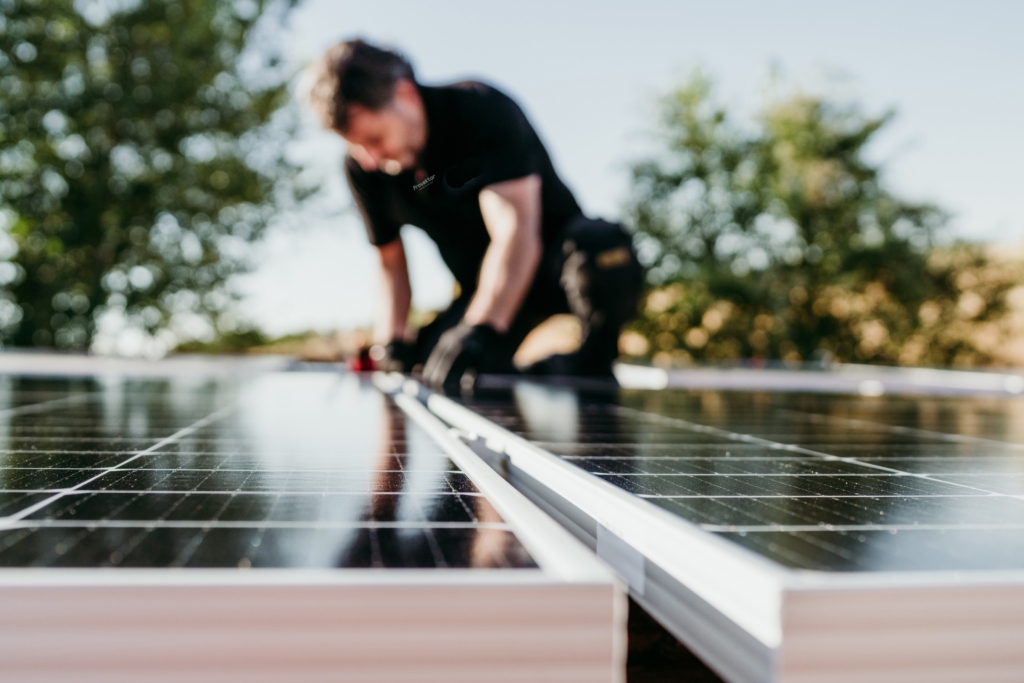
Effektiv investering
Allt fler elleverantörer och nätbolag debiterar numera extra för maximal månadseffekt och går allt oftare över till timdebitering. Det kan innebära högre elräkningar för många, eftersom mycket av elförbrukningen måste ske under dagtid – för vem vill laga mat eller gå upp och tömma tvättmaskinen mitt i natten? Ofta är elbilsladdning den enda förbrukning som kan styras över till lågpristimmarna.
De högre elpriserna i kombination med allt effektivare solcellsteknik har därför på bara några år medfört att en investering i egen solkraft har gått från att vara ett idealistprojekt till en god investering som betalar sig ganska snabbt – särskilt med de nya möjligheterna till skattereduktion för installation av grön teknik.
Kapa effekttopparna • Minska dina elkostnader • Sälj överskottet • Höj värdet på huset
Solpaneler med optimerad energiekonomi
Att sätta upp solpaneler har alltså aldrig varit ett så självklart beslut som det är idag. Men det handlar inte om att montera upp så många paneler som får plats på taket. Det gäller att optimera utbytet för en så bra kombination som möjligt av egen användning och säljbart överskott i förhållande till den investering du gör – och till de villkor din elleverantör och ditt nätbolag ställer upp, idag och i framtiden.
Det är mycket som behöver tänkas igenom: Hur ser din förbrukning ut över dygnet och året? Är ditt värmesystem elberoende? Passar det bäst med paneler som ligger platt på taket – eller uppvinklade? Kanske på fasaden istället för taket? Har ditt lokala nätbolag eventuella restriktioner för nyanslutning av solpaneler till nätet? Hur påverkas priset du får för överskottselen som matas ut på elnätet av om du har fast eller rörligt elprisavtal? Innebär solcellerna att du kan välja en mindre huvudsäkring för att få en lägre fast avgift? Och så vidare.
Kort sagt: du behöver en kompetent leverantör som guidar dig förbi fallgroparna, en som känner de lokala förhållandena, en som hjälper dig med alla kalkyler och vet vilka komponenter som passar bäst för just ditt hus och dina behov.

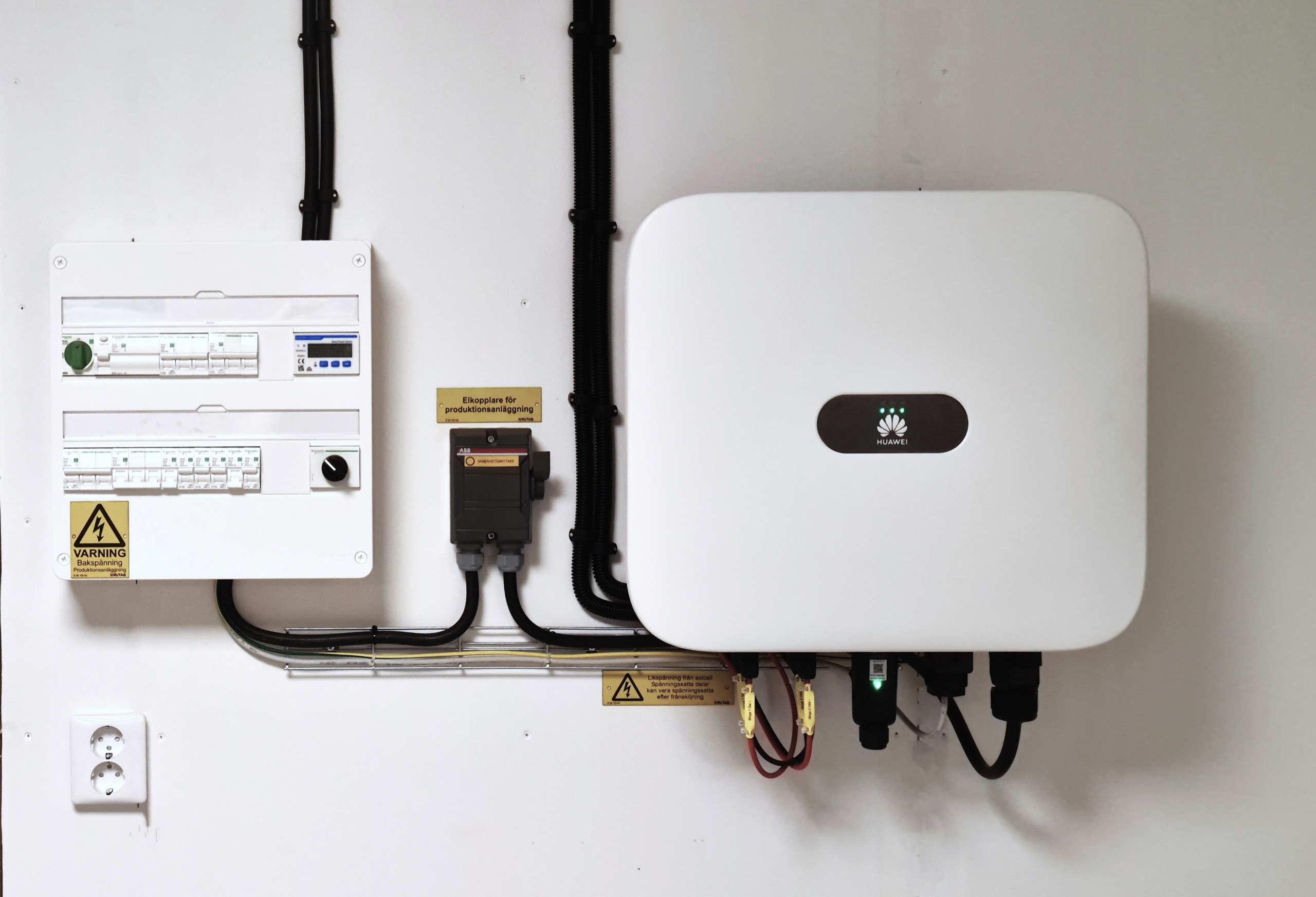
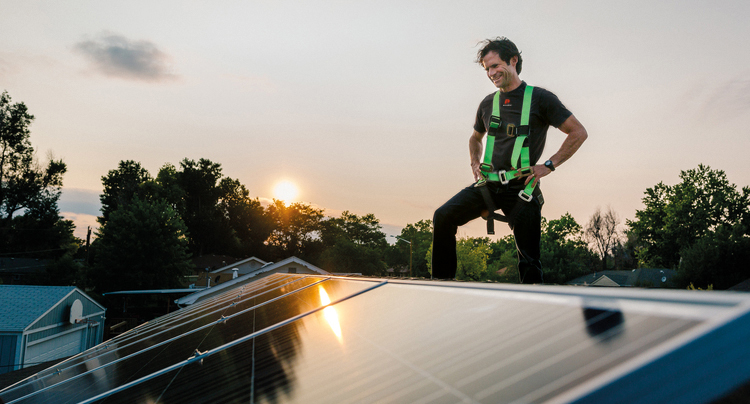
Batterilagring för villafastigheter
Med batterilagring av el kan en solcellsanläggning gå från ett lönsamt tillskott till en verkligt effektiv lösning som kanske till och med kan göra dig oberoende av elnätet under stora delar av året. Med ett batteri kan du lagra överskottselen för användning när den behövs som bäst, för att bli så självförsörjande som bara är möjligt. Fyll på batterierna under dagen och använd elen till att ladda bilen på natten, och så vidare. För konsumentmarknaden finns batterilösningar för att lagra upp till 20 kWh eller ännu mer, vilket innebär att solpanelerna kan täcka behovet av hushållsel över hela dygnet för en normalvilla även vintertid.
Med ett väldimensionerat batteri kan du utnyttja variationerna i timpriser över dygnet för att automatiskt köpa eller sälja el till eller från nätet när det ger bästa möjliga utfall. Du kan dessutom kapa effekttoppar och därigenom minska dina kostnader för abonnerad maxeffekt. Vi hjälper dig gärna att räkna på om en batteriinvestering lönar sig för just ditt hus!
Minskande andelar av reglerbar kraft i elmixen innebär också att elnätet utsätts för stora påfrestningar då efterfrågan och utbud blir svårare att balansera. Om du har ett batteri i din solcellsanläggning kan du hjälpa till att jämna ut utbudet för elnät som helhet– och få betalt som tack för hjälpen.
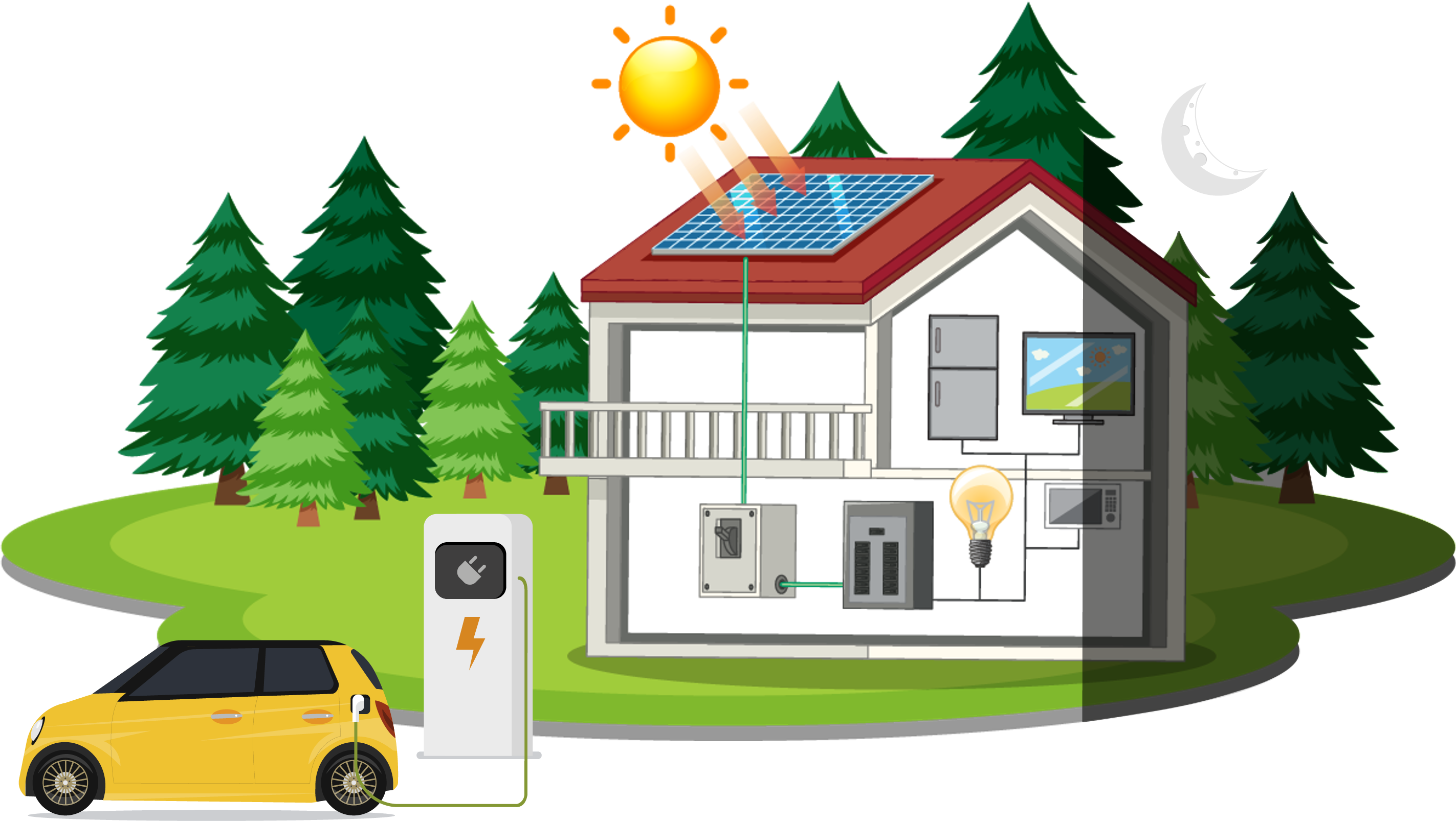
Från idé till driftklar anläggning
Vi på Provektor gör det enkelt och smidigt för dig att bli din egen elproducent. Vi börjar med ett besök där vi går igenom dina förutsättningar och önskemål. Sedan tar vi fram ett systemförslag och en offert. När vi är överens drar vi igång installationen och sköter alla kontakter med ditt nätbolag – och hjälper dig att söka skattereduktion för grön teknik.
Alla arbeten utförs av våra behöriga montörer och elektriker som har stor vana från solcellsmontage. Så snart nätbolaget har genomfört sina kontroller kan du börja njuta av egentillverkad el med gott samvete! Hör av dig, så räknar vi på vad som blir optimalt för dig.
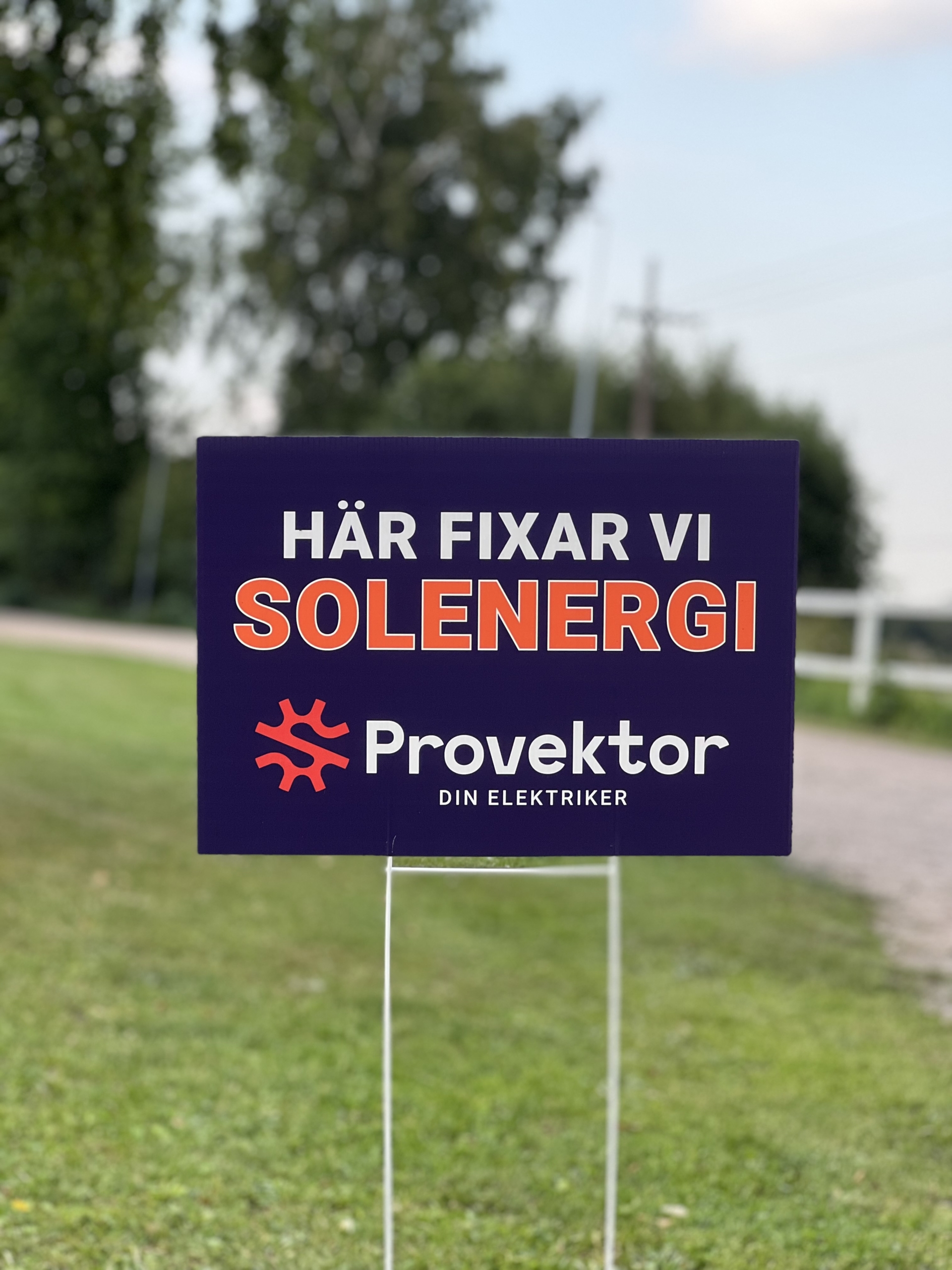
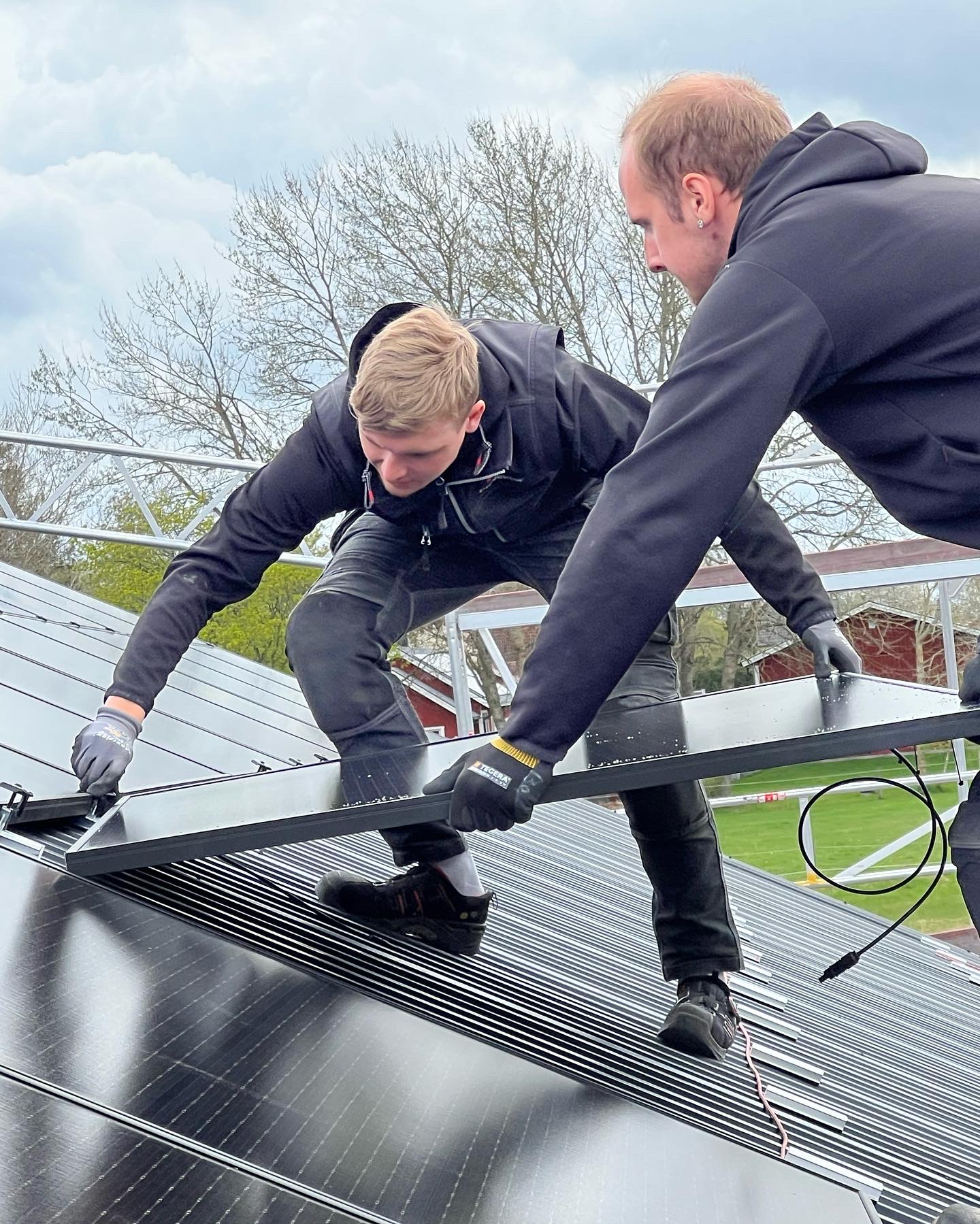
Skatteavdrag för grön teknik
Ungefär som med ROT-avdrag kan du få pengar tillbaka på skatten när du installerar grön teknik. Det ger för närvarande en skattereduktion på 20% av kostnaden för solenergianläggningar och 50% för batterilagrings- och fordonsladdningslösningar. Avdragen görs direkt på fakturan, men tänk på att du måste betala tillräckligt med skatt från början för att inte bli återbetalningsskyldig för en del av summan.
Läs mer om Grön teknik-avdraget hos Skatteverket!
Referenser
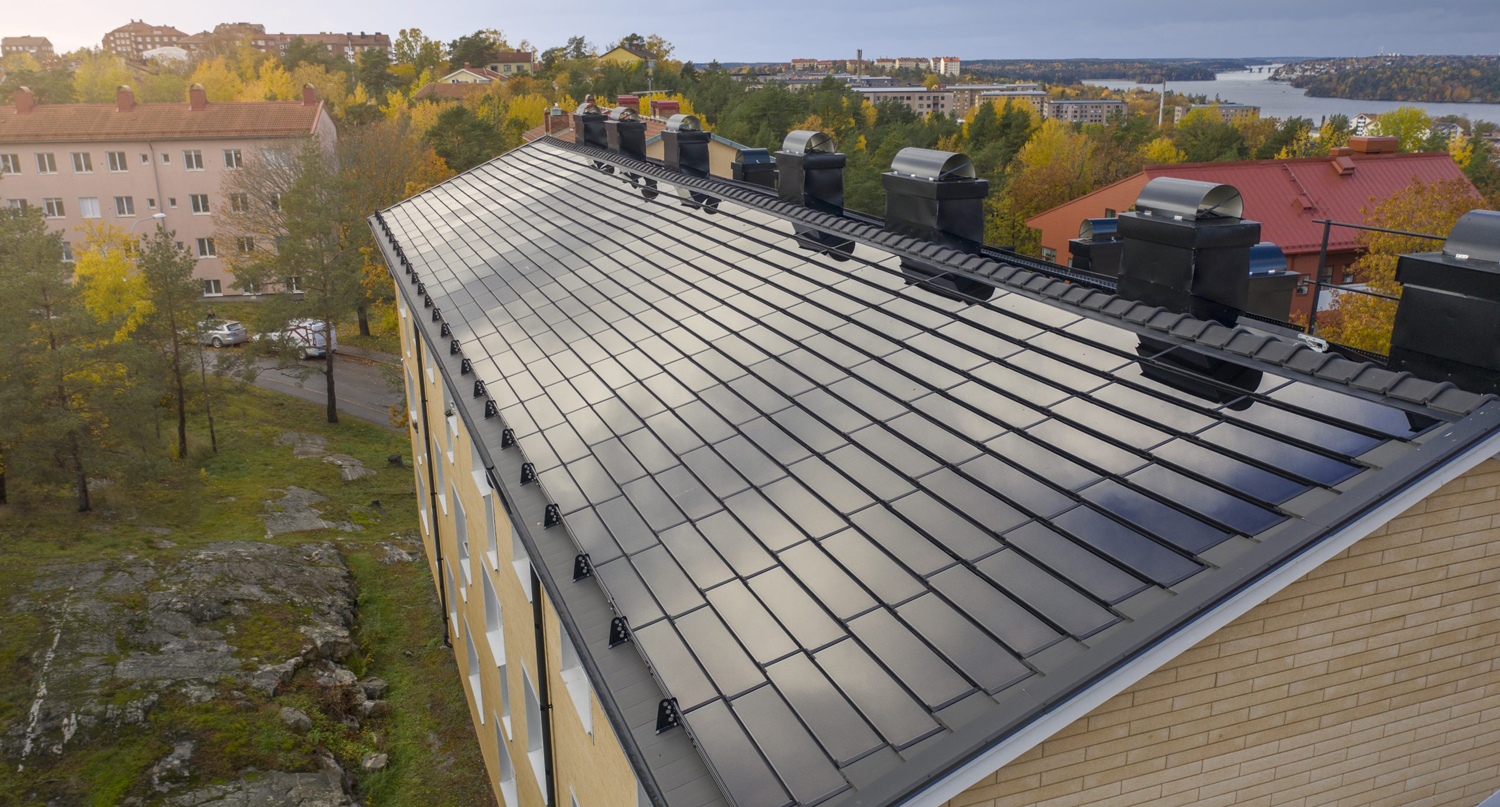
Vanliga frågor om solceller – svaren på dina funderingar
Oftast inte! Om panelerna följer takets eller fasadens form, om du sätter upp solpaneler på marken i måttlig omfattning eller om ditt hus ligger utanför detaljplanerat område – då behöver du i de flesta fall inget bygglov, såvida inte huset är kulturminnesskyddat. Men kolla alltid med kommunens plan- och byggkontor för säkerhets skull.
En solpanel består av celler av halvledarmaterial som generar elektrisk ström när de träffas av solljus. Cellerna byggs ihop till paneler som kan placeras på tak och fasader eller på marken.
För att elen från solpanelerna ska kunna användas i ditt hus kopplas den genom en växelriktare. Det är en krets som omvandlar likströmmen från cellerna till den typ av 240 V / 50 Hz växelström som vanliga elapparater behöver för att fungera. Växelriktare kan också användas ihop med batterier som lagrar elen dina paneler producerar.
Det är många faktorer som avgör hur effektiv en solpanellösning blir. Husets geografiska läge, takets lutning och i vilka väderstreck det ligger, om det skuggas av omkringliggande träd eller byggnader – och förstås hur stort det är. Generellt kan man säga att solpaneler fungerar bra på nästan alla tak, bara med lite olika hög verkningsgrad. ”Svåra” tak kan alltså behöva något fler paneler för att ge samma utbyte som ett idealt tak. Allra bäst utbyte blir det med en lutning på 35–45 grader på ett tak som vetter rakt mot söder. För att maximera din egen användning av elen över dygnet kan det dock vara bättre att lägga panelerna i öst/västlig riktning – vi hjälper dig att välja rätt efter just dina förutsättningar.
Som tumregel kan man säga att paneler på 1 kW (cirka 5 kvadratmeter) ger mellan 800 och 1100 kWh per år. Många villaanläggningar brukar ha mellan 40 och 80 kvadratmeter solpaneler på 8-16 kW, som då alltså ger mellan 8000 och 16000 kWh per år. Det kan jämföras med att en normalvilla med en familj på fyra personer förbrukar i storleksordningen 5000 kWh hushållsel per år, exklusive varmvatten och värme.
Nej, solpanelerna genererar ingen el på natten, men med batterilagring i systemet kan du flytta överskottet som blir under dygnets ljusa timmar till kvällen och natten. Det innebär att du kan bli mer eller mindre självförsörjande på el under sommarhalvåret, beroende på hur anläggningen är dimensionerad. Även utan batteri sparar du pengar, eftersom du kan få betalt för den överskottsenergi som produceras under dagen.
Snö på panelerna stoppar det mesta av elproduktionen, men det brukar inte vara speciellt många dagar under en genimsnittlig vinter som snön ligger kvar. Ju kraftigare lutning på taket och panelerna, desto mindre påverkas du av snön.
Det beror mycket på elprisernas utveckling och hur du finansierar investeringen, men man brukar räkna med att en modern solenergianläggning betalar sig på så kort tid som 8–12 år.
Hur bra det lönar sig beror på hur mycket effekt dina paneler ger och hur stor batterikapacitet som behövs för att helt jämna ut behoven. Tryggheten är också en viktig faktor att tänka på i sammanhanget, med möjligheten att få egen el till varmvattnet, spisen, datorn och teven även om det blir strömavbrott i kvarteret – eller om det i framtiden blir aktuellt att stänga av elleveranser under vissa tider om det råder brist på kapacitet under belastningstoppar.
Det tar vanligtvis runt en vecka att installera solceller, lite beroende på hur stor anläggningen är. Sedan kan det ta några veckor innan nätbolaget har kommit och kontrollerat att de kan bryta strömmen på ett korrekt sätt – först då kan produktionen starta.
Hur mycket du kan få betalt varierar mellan olika elhandelsbolag och abonnemangstyper. Vi har full koll på vad som gäller i dagsläget och hjälper dig att hitta en lösning som maximerar din ersättning.
Underhållsbehovet är minimalt, men det kan vara bra att se över dem ett par gånger om året så att ingen skada har uppstått samt att du får ut maximal effekt av din anläggning. Den elproduktion som går förlorad när de är täckta av snö är måttlig, och det är mycket värre om du repar eller spräcker en panel genom att skotta på taket.
Det är endast utbildad personal och företag med elbehörighet som får installera solceller. Installatörsföretaget ska dessutom vara registrerat hos Elsäkerhetsverket. En nätansluten solcellsanläggning räknas som en starkströmsanläggning, vilket kan påverka din villahemförsäkring. Fastighetsägaren har det yttersta ansvaret för sin elanläggning, inklusive att installationen är utförd på ett korrekt och säkert sätt av en behörig installatör. Väljer du Provektor som leverantör kan du vara tryggt förvissad om att så är fallet.
Hos Elsäkerhetsverket kan du kontrollera om ett installatörsföretag är behörigt.
Nyfiken på vad vi kan hjälpa dig mer med som privatperson?
